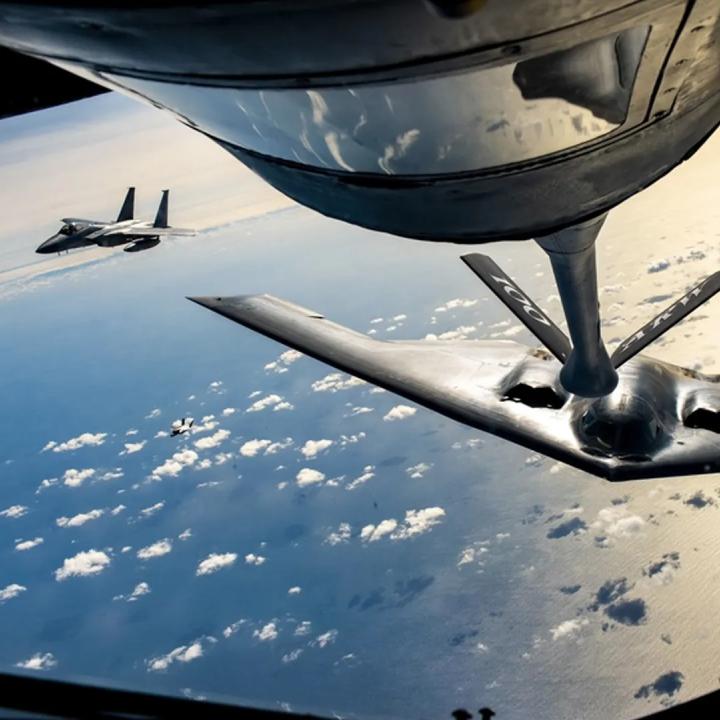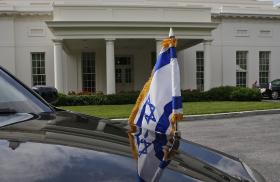
- Policy Analysis
- PolicyWatch 4060
U.S. Attacks Iranian Nuclear Sites: Implications for Israel, the Middle East, and U.S. Policy

Two veteran U.S. officials join a former Israeli ambassador to discuss the effects and future consequences of the Trump administration’s decision to strike Iran’s nuclear program.
On June 23, The Washington Institute held a virtual Policy Forum with Dana Stroul, Michael Herzog, and Dennis Ross. Stroul, the Institute’s director of research and Kassen Senior Fellow, formerly served as deputy assistant defense secretary for the Middle East in the Biden administration. Herzog is a retired brigadier-general with the Israel Defense Forces (IDF) and served as ambassador to the United States from 2021 to 2025; he is currently rejoining the Institute as the Tisch Distinguished Fellow. Ross is the Institute’s Davidson Distinguished Fellow and a former senior White House and State Department official in the Reagan, Bush, Clinton, and Obama administrations. The following is a rapporteur’s summary of their remarks.
Note: This forum took place before Tehran’s retaliatory strike on U.S. facilities in Qatar and the subsequent announcement of a ceasefire between Iran and Israel, so the discussion does not reflect those developments.
Dana Stroul
After the October 7 Hamas attack on Israel, President Biden set deliberate expectations for how American military power would be used in the Middle East: to protect U.S. forces, support Israel’s defense, and prevent the Gaza war from escalating further. He directed a significant increase in America’s military posture, while U.S. Central Command organized a multilateral air defense coalition to defeat Iranian missile and drone attacks. President Trump’s June 21 decision to launch a military strike against nuclear sites in Iran marks a significant departure from that approach, shifting from defense to offense.
Dubbed “Operation Midnight Hammer,” the strike showcased the unparalleled capabilities of the U.S. military, requiring a combination of precision, discretion, and coordination that no other armed force could have achieved, especially so far from its own shores. The operation was noteworthy in several respects: for its stealth, thanks in part to minimal communication from the B-2 pilots after takeoff; for its coordination among U.S. combatant commands and between the American and Israeli militaries; and for the first operational use of the Massive Ordnance Penetrator. Such a complex operation is the result of long-term planning—the tactical success of all elements is due in no small part to resourcing, joint exercises, and planning that have taken place over years.
While the strike was executed flawlessly, the extent of damage caused to critical elements of the nuclear program remains unclear. And regardless of the physical destruction, no military operation alone can completely and permanently eliminate the program. Iran likely moved nuclear components from high-profile sites like Fordow ahead of the attack, and the regime still retains the knowledge required to build a nuclear weapon despite the targeted killing of top defense officials and nuclear scientists. Thus, a diplomatic solution is required to address the nuclear threat in the long term.
The Trump administration hopes that Operation Midnight Hammer and Israel’s Operation Rising Lion will bring Iran back to the negotiating table, this time ready to make meaningful concessions. While that is certainly a possibility, it is by no means the only potential outcome. Tehran could return to negotiations but remain intransigent, or it could refuse to restart talks at all—a position that might prompt another round of U.S. strikes.
Regardless of which diplomatic path it chooses, Iran will retaliate kinetically in some way, if only as a face-saving measure for regime security. This might come in the form of proxy militia attacks, strikes on U.S. forces in the region, attacks on Gulf energy infrastructure in an attempt to drive a wedge between Washington and its partners, or activation of sleeper cells around the globe, including inside the United States.
Michael Herzog
There is a direct line connecting the current Iran war with October 7. While the brutal Hamas attack on Israel was not tactically coordinated with the rest of Iran’s “axis of resistance,” it was designed as part of Tehran’s long-term strategy to destroy Israel. This was not merely a vision; it was an operational plan with a specific timeframe that included the buildup of all “axis” forces. Once the October 7 attack unfolded, perceptions of Israeli weakness and vulnerability led Iran, Hezbollah, and other axis members to embark on their own military campaigns. Consequently, Jerusalem concluded that this war could not end just with Gaza; it required confronting the Iranian axis as a whole.
After turning the tables on the axis, Israel began to focus on the “big prize”: Iran’s nuclear program. Last November, it formulated a military plan to neutralize Tehran’s strategic capabilities based on new evidence that the regime was resuming progress toward weaponization and reconstituting its missile capabilities in a more dangerous way. The plan’s goal was to set back the nuclear and missile threats significantly and create the conditions to completely neutralize the nuclear program through follow-on diplomatic or military efforts.
Although the November plan was born out of necessity, it also took advantage of the unique opportunity presented by Iran’s weakened state following the decimation of Hezbollah, the revolt against the Assad regime, and the reduction in Iranian missile capabilities via Israeli strikes the previous month. For their part, Iranian officials seemingly failed to understand the degree to which Israel had changed after October 7—namely, that it would no longer tolerate the buildup of threats by enemies sworn to its destruction.
The current campaign began with the element of surprise, as initial strikes secured freedom of flight to and above Iran and decapitated the regime’s senior defense establishment (which also disrupted its decisionmaking on a response). The operation has mainly focused on degrading missiles and launchers (around two-thirds of which are believed to be destroyed or incapacitated) and neutralizing every major element of the nuclear program. Although the final results are still being determined, Iran seems to have been dealt a severe blow on all these counts.
The campaign was also launched with U.S. approval and the knowledge that Washington would actively support Israel’s defense. Jerusalem was not sure at the outset whether U.S. forces would join in offensive strikes against the nuclear program, so it made plans to achieve its goals on its own. Once Washington decided to join the strikes, it marked a significant turning point in terms of ensuring the destruction of Iran’s nuclear capabilities, expediting the war’s end, and signaling a commitment to prevent Tehran from reconstructing these capabilities.
Although Israelis are deeply divided on many issues, most of them agree on the need to address the Iranian threat. This consensus has provided the government with broad support for the current campaign, even when the impact of Iranian retaliation required great civilian sacrifice. Israeli society is very resilient, with an ethos that makes people willing to pay the price required to remove an existential threat.
The next steps in the conflict largely depend on how Iran responds to the U.S. strike. The regime has an array of retaliation options but is also weaker than it has been for decades, with so much more to lose, so it can probably be convinced to limit its response. Tehran is unlikely to rush back to the negotiating table soon, however.
Once the war ends, Israel and the United States must stay vigilant and maintain freedom of action against any Iranian attempts to reconstruct the nuclear program. Of particular concern is the regime’s stockpile of 60 percent enriched uranium—how much of it survived, where is it hidden, and does Iran intend to weaponize it?
Israel’s war goals do not include regime change, and for good reason—that is something the Iranian people must achieve themselves. Yet Israeli officials did note that they have the ability to eliminate the Supreme Leader if necessary, and some of the operation’s targets have been tied to regime stability. These steps were intended to signal Tehran that it stands to lose its grip on power if it escalates, while also fostering conditions that could contribute to regime instability after the war if the Iranian people move in that direction. (It was clear that they would not rise up against the regime while Israeli planes are bombing Iran.)
On the broader regional stage, one hopes that enhanced Israeli and American deterrence will allow for progress on resolving the Gaza conflict (based on the release of all remaining hostages) and normalizing Israeli-Saudi relations. Officials should also conduct a fresh review of what is required to solidify the unique U.S.-Israeli defense partnership in this new Middle Eastern strategic landscape.
Dennis Ross
Although Operation Midnight Hamer was an extraordinary military achievement, the tactical prowess on display will be squandered if Washington does not translate it into an enduring political outcome. The opportunity of this moment is great if managed properly.
For Iran, regime survival is paramount. While Supreme Leader Ali Khamenei will need to respond to the U.S. strike in some fashion, Iran’s current weakness means that any retaliation—at least in the immediate future—will be limited and largely symbolic. Failure to respond at all would convey so much weakness that it could threaten the regime’s survival; this same risk also explains why Tehran has historically sought to avoid direct conflict with the United States. The Trump administration should therefore recognize the regime’s need for a face-saving measure. Tehran would also find it easier to respond favorably to ceasefire terms if they come from Russia, China, or Qatar instead of Washington.
No matter how Iran tries to save face, however, regional and global perceptions of its strength have been dramatically undercut by the events of the past ten days. The Islamic Republic has been exposed as a hollow power, and its ability to coerce the region is mostly gone. This is the moment to build the regional coalition that the United States has envisioned and pursued for some time.
Iran’s current weakness could also lead to regime change, though that prospect is complicated by two critical elements: first, the absence of an organized opposition within Iran (and a fractured diaspora abroad); second, the need for a credible authority in Tehran with which the United States can negotiate. A public information campaign to encourage the coalescence of a credible opposition inside the country may be in America’s interest, but the value of such a move would depend greatly on the status of negotiations and how the Trump administration balances the tensions between these interests.
As for Prime Minister Binyamin Netanyahu, Iran has always been his “Churchill issue.” He understands that ending the threat is important in its own right—and also that it could mitigate the stain he bears due to the Gaza war. Success against Iran would put him in a better position to get the remaining hostages out of Gaza, reach a ceasefire with Hamas, and move to a genuine, imminent discussion of a “day after” strategy that ensures security and prosperity for Israelis and Palestinians alike. Similarly, President Trump has a chance to seize the moment—or else be plagued by the domestic and international effects of this war for the rest of his administration.
This summary was prepared by Cleary Waldo. The Policy Forum series is made possible through the generosity of the Florence and Robert Kaufman Family.






